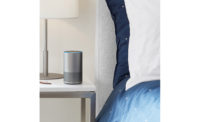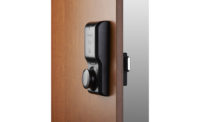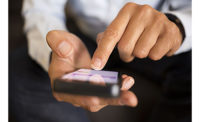Advances in technology have put smart home capability within the reach of most security systems buyers, greatly enhancing security’s consumer appeal — and one of the most appealing smart devices is the smart lock. Smart locks eliminate the need for a traditional key, instead relying on a code or smartphone app to unlock a door. They can be integrated with a security system, making them even more powerful.
Why Sell Smart Locks
About 50 percent of end users who purchase smart home capabilities include a smart lock, according to Ilan Dee, director of software product management and marketing for Melville, N.Y.-based security and smart home system manufacturer Honeywell Homes. But some people think that number should and will be higher.
“Once you have it, you can’t live without it,” comments Dee. He notes that he has a smart lock in his own home and has grown accustomed to not pulling out a key to unlock the door — a particularly helpful capability when he is carrying something. Newer automobiles now have keyless entry and as people become accustomed to having that capability for their cars, they will want it for their homes as well.
A smart lock integrated with a security system can be set up to automatically disarm the system when the lock is unlocked, adding an additional level of convenience. And if desired, the system can be set up to turn on certain lights or trigger other functionality when the door is unlocked. Another option is to have the door automatically unlock if a smoke or CO detector is triggered so that the fire department doesn’t have to destroy the door to gain entry, notes Nick English, national sales manager for Lake Forest, Calif.-based smart lock manufacturer Kwikset.
Sources interviewed for this article were unanimously enthusiastic about the smart lock’s ability to enhance customer retention.
As English explains, a customer might not need to interact with his or her system if a smart thermostat were the only smart device. And if that customer gets out of the habit of arming and disarming the system, he or she might opt not to renew when the contract is up for renewal.
With a system that includes a smart lock, however, “once you get the features and benefits and use them regularly, it becomes such an integral part of your life, that not many would cancel,” English describes.
Some dealers offer several different tiers of smart home packages and will want to seriously consider including smart locks in at least one of those packages if they aren’t doing so already. Providers of the cloud services that underlie smart home connectivity generally have a set monthly charge for security systems with smart home capability and that charge doesn’t vary regardless of the number of smart devices included, sources say.
Amazon Key Inspires Imitators, Future Opportunities
Would you let a delivery person gain entry into your house while you’re not home to leave a package? How homeowners answer this question
will determine the success of Amazon Key — an offering from online retail giant Amazon available in certain markets that offers a unique twist on the smart lock.
For a price of $249.99 to $314.99, depending on the exact device purchased, Amazon will ship a smart lock and a camera designed for the homeowner to self-install to support free inhome delivery. The camera is installed indoors facing the door on which the lock is installed. Homeowners also must be Amazon Prime customers.
As Amazon explains on a Web page devoted to Amazon Key, customers that have purchased the Amazon Key service gain typical smart key capabilities such as the ability to unlock the door without a key, including from remote locations. In addition, the customer can see a video clip of anyone who enters their home — and can have packages that are ordered through Amazon Prime delivered inside of the home.
Amazon did not respond to an interview request in time for SDM’s deadline, but it appears that the service is only available in areas where the company has its own delivery people as the company’s website notes that “Amazon Key in-home deliveries are carried out by some of the same professional drivers who you trust to deliver your Amazon orders today. These individuals are thoroughly vetted, with comprehensive background checks and motor vehicle records reviews.”
Amazon also noted that delivery people do not get a code to enter the home. Instead, “Amazon verifies that the package belongs to the address and the driver is near the door, turns on Amazon Cloud Cam and unlocks your door.”
Amazon developed its own software to support the offering, which is delivered through Amazon’s own cloud infrastructure, explains Kevin Kraus at Yale, which provides some of the smart locks used with Amazon Key. Kwikset is also a supplier.
“I’d sign up if I lived in a multidwelling unit,” comments Kraus. Some stakeholders are more skeptical.
“People are still concerned about letting strangers into their house,” observes Ilan Dee, director of software product management and marketing for Honeywell Homes. He suggests that an offering that allows delivery people to leave packages in the customer’s garage would make more sense.
In-garage delivery might not be a good match for what Devin Love, Carmel, Ind.-based smart lock supplier Schlage, sees as a more compelling application for unattended delivery, however — grocery delivery. He notes that grocery retailer Kroger has seen steady increases in the number of people who order groceries for pick-up at the store and he sees in-home grocery delivery as the logical next step, although he notes that there are still some hurdles to get over.
One downside to the Amazon Key offering is that it doesn’t interface with the customer’s alarm system. The Amazon Key Web page advises customers to leave the alarm system disarmed on days when they are expecting deliveries. Addressing that drawback could be an opportunity for the security industry.
“In the future we’ll see collaboration,” Kraus observes. “Will an alarm company take the lead? That may not be their core competency, but they will become participants.”
Love suggests another possibility. He sees an opportunity for security dealers to work with delivery companies such as United Parcel Service or their competitors to offer a service that would compete with Amazon Key.
In the meantime, Nick English, Kwikset, notes that some security dealers are offering systems and capabilities similar to Amazon Key but because the dealers don’t control the delivery side of the offering, the homeowner has to be in a position to see a smartphone notification when the delivery person arrives and remotely unlock the door at that time. On the plus side, the homeowner doesn’t have to self-install the
equipment or disarm the alarm system on delivery day.
In-home delivery clearly is a nascent offering, but one that bears close attention as it evolves.
Some homeowners may be tempted to install their own smart locks and it’s important to note that these locks are available with cloud service support without a monthly recurring fee, which could enhance their attractiveness to some customers in comparison with dealer-installed systems.
Dealers will want to emphasize the added sense of security that a dealer-installed system can provide.
“They’re completing the installation in a professional way, no matter the season,” comments Kevin Kraus, director of technology and partner integration for New Haven, Conn.-based smart lock maker Yale, a division of ASSA ABLOY.
Kraus notes that this may be particularly important for customers who purchase smart locks for the homes of aging parents — an important niche within the smart lock category. Adult children like to know they can let emergency personnel or a trusted neighbor in to their parent’s home when needed.
Dealers also may want to pursue smart lock opportunities in the vacation rental market, Kraus notes.
Moving forward, dealers may want to keep an eye on other opportunities to add value to a security system, such as unattended delivery.
The upshot is that including smart locks in a security system can help ensure that customers use and get value from their systems, which in turn can increase the likelihood that the homeowner will remain a loyal customer for years to come.
More Online
For more information about smart locks, visit SDM’s website where you’ll find the following articles.
“Function Takes Many Forms in the World of Smart Locks”
www.SDMmag.com/function-takes-forms-smart-locks
“73% of Smart Home Device Owners Installed the Product Themselves”
www.SDMmag.com/73-percent-smart-home-owners-installed-product
“Starting the Smart Right at the Front Door”
www.SDMmag.com/starting-smart-front-door
“5 Things You Need to Know About Connected Locks”







